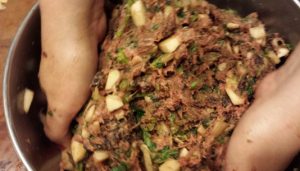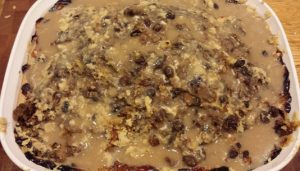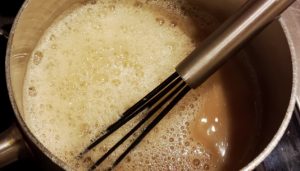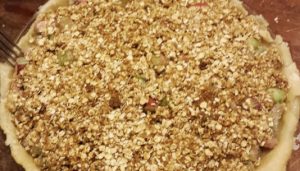We’ve all had to “eat humble pie” at one time or another, a saying that hearkens back to the medieval period, when the term meant that one was eating a dish made with the scrap meat from a successful hunt or slaughter[i]. Where the master of the house might get a fine roast, the servants would feast on what was left.
The term “humble pie” seems to have arisen as a bit of verbal slippage from the earlier term, derived from a Middle French word “nomble,” which referred to the scrap meat, so you were making “a nomble pie,” which could–and apparently was–be easily mistaken for “an ‘umble pie.”
Through a similar linguistic slippage, the elaborate “Lombard pie” became known as a “lumber pie,” and then appears to have even become conflated with the simpler “humble pie,” to the point where 18th-century cookbooks state outright that the same recipe will answer for either pie.
The modern meaning seems to already have been an implication by the time of the Revolution, as a brain teaser published in London’s Hibernian Magazine in 1774 gives a clue of “pride reversed in a pie” for the answer of “Humble Pye.”[ii] (Fascinatingly, the answer key alongside an account of the reactions of the unruly denizens of Boston to what is referred to benignly as the “Boston Port Act,” but which is recorded in American histories as one of the “Intolerable Acts,” passed in response to the Boston Tea Party.[iii])
This recipe is from Elizabeth Smith’s 1739 cookbook, The Compleat Housewife[iv], which was almost certainly brought over to educate the kitchens of wealthier American colonists. I’ve incorporated some hints from the suspiciously similar recipe in the earlier Court Cookery[v] to help clarify some of the places where the more egalitarian book’s copy of the recipe was muddled in the adaptation.
Humble Pie
Preheat the oven to 425° F (220° C). Blend together with your hands:
3 lbs (1.5 kg) ground beef, 20% or greater fat content
5 green apples, peeled, cored and sliced thin
1/2 c (125 ml) fresh spinach, rinsed
Head of romaine lettuce, shredded
6 c (225 ml) plain breadcrumbs
1 1/2 lb (250 g) raisins or dried currants
1/2 cup (125 ml) apricot preserves
1 tbsp (15 ml) parsley
1 tsp (5 ml) thyme
1 tsp (5 ml) mace, ground
1 tsp (5 ml) nutmeg, grated
2 tsp (10 ml) cinnamon, ground
3 egg yolks
2 tbsp (30 ml) cream sherry
4 tsp (20 ml) orange blossom water
Originally, a lumber pie would be housed in an elaborate crust of very stiff pastry, baked without the assistance of a pie plate of any sort[vi]. However, we’ll take the easier path of simply lining a large casserole dish with a double recipe of a standard pie crust, and then placing the meat mixture into it. Roll out a lid and cut decorative vent holes into it.
Bake for 10 minutes, then reduce heat to 350° F (175° C) and bake for another hour and a half.
While the pie bakes, prepare the caudle (below). When you remove the pie from the oven, either pour the caudle through the vent holes and tilt it to spread it, or remove the top crust entirely and pour the caudle over it. Serve hot.
Caudle
Whisk together in a saucepan:
1 cup (225 ml) cream sherry
1 cup (225 ml) white table wine
1 tbsp (15 ml) balsamic vinegar
1/4 cup (60 ml) sugar
Bring to a boil, and then remove from heat. In a glass bowl or measuring cup, beat until frothy:
2 eggs
Whisking constantly, slowly add about half of the hot wine to the egg mixture, until well-blended, and then slowly pour the egg mixture back into the remaining hot wine, continuing to whisk constantly.
Rhubarb Pie
Rhubarb was known in the Revolutionary era, but its usage seems to have been primarily medicinal[vii]. With the ready availability of sugar, though, its natural sourness could be balanced, and by 1777, we find a brief recipe for a rhubarb tart, which advises the cook to treat it similarly to gooseberries[viii], which are also fairly sour in their natural state.
A tart of the period would be prepared in an open pastry shell, though we might today call it a pie. We’ll add a crumb topping to the filling, which highlights the wonderful robust flavor of the rhubarb, while giving it a bit more body than the advice Charlotte Mason offers in 1777, which appears to be simply to bake it until it has turned red.
Preheat the oven to 375° F (190° C) and prepare a standard single pastry crust. Cut into the bottom of the crust in small pieces:
1 tbsp (15 ml) butter
Combine in a glass bowl:
5 1/2 cups (1250 ml) rhubarb, cleaned and sliced into small chunks
1/4 tsp (2 ml) baking soda
1 2/3 (400 ml) cups sugar
1/3 cup + 1 tbsp (100 ml) flour
Toss rhubarb in flour and sugar and put in crust. Blend together:
2 tbsp (30 ml) butter
1/3 cup (75ml) brown sugar
1 cup (225 ml) rolled oats
Spread oat mixture over rhubarb, finish the edges with a fork or your fingers to flute the crust nicely, and bake for about 45 minutes, until the topping is browned.
[i] Lyman, Darryl. Yahoo!, “‘Eat Humble Pie’: Origin and Meaning of the Expression.” Last modified Jul 24, 2009. Accessed August 25, 2013. http://voices.yahoo.com/eat-humble-pie-origin-meaning-expression-3810028.html.
[ii] “An Enigmatical Representation of a Real Entertainment.” The Hibernian Magazine, October 1774. http://books.google.com/books?id=MrURAAAAYAAJ (accessed October 16, 2013).
[iii] “Account of the Proceedings of the American Colonists, since the Passing of the Boston Port Bill.” The Hibernian Magazine, November 1774. http://books.google.com/books?id=MrURAAAAYAAJ (accessed October 16, 2013).
[iv] Elizabeth Smith, The Compleat Housewife, (London: J. and J. Pemberton, 1739) http://books.google.com/books?id=XvMHAAAAQAAJ (accessed August 25, 2013), 9.
[v] Robert Smith, Court Cookery, (London: T. Wotton, 1725) http://books.google.com/books?id=O_AHAAAAQAAJ (accessed August 25, 2013), 140.
[vi] Day, Ivan. Historic Food, “Make Metes and Mince Pies.” Last modified 2003. Accessed August 25, 2013. http://www.historicfood.com/Pie recipe2.htm.



















One thought on “Anything But Humble: Pie for Dinner”
I just wanted to drop a quick comment to thank you all for this website. Thank you for the research you all have done and the effort expended in writing the articles. A big, special thank you for all of these remarkable recipes!
I homeschool my children. Currently, my sixth grade boy is studying World History, and my fifth grade boy is learning about the history of the United States. We are trying to incorporate music and food from the eras and geographical locations to help give us an idea of what individuals experienced. These articles and the recipes are really helping to add fullness to our lessons.
Thank you again!